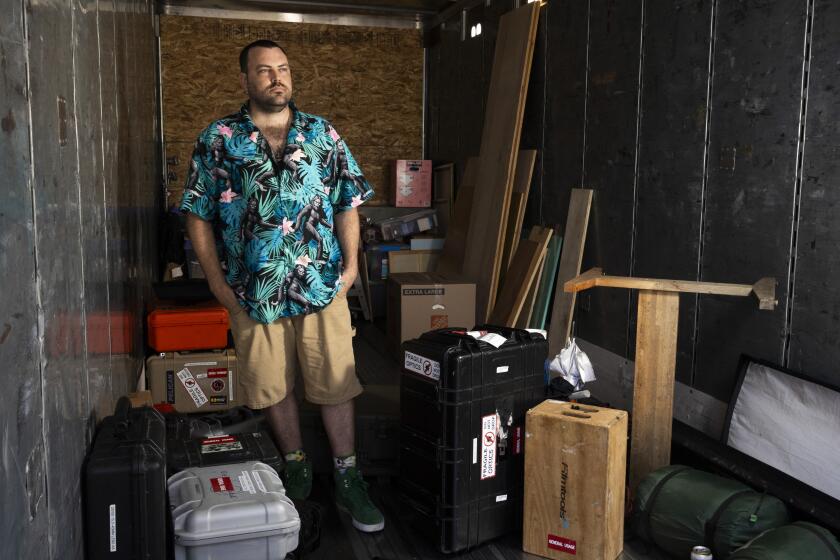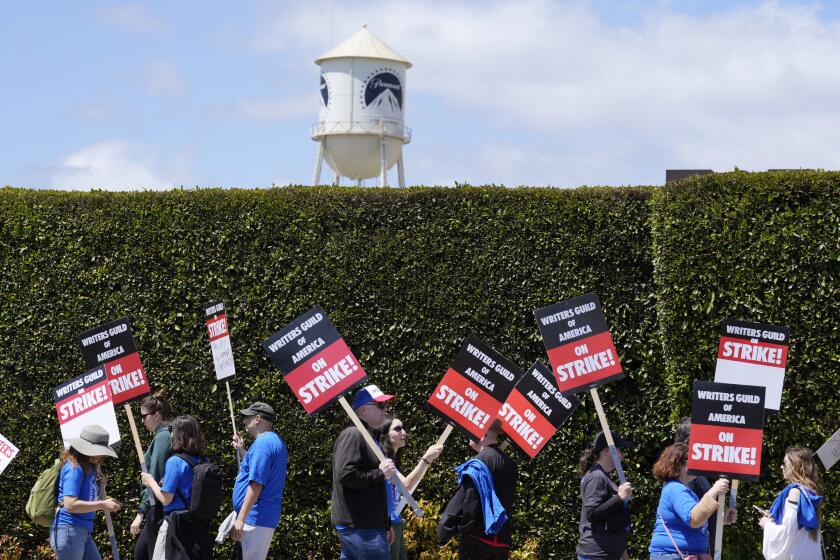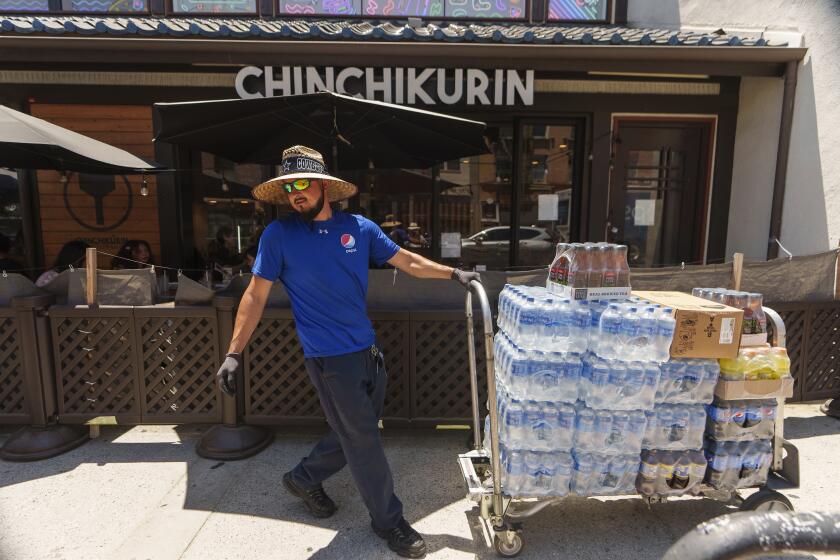
- Share via
Ever since the actors’ strike ended last year, Hollywood’s workforce has been asking one question: When will the entertainment industry’s production economy start its long-awaited comeback?
A full nine months after the debilitating “hot labor summer” and fall concluded, a picture is starting to emerge of an industry in a state of modest recovery. New data indicate that, after a long period of significantly reduced activity, some companies are commissioning more shows again, but the comeback remains incredibly slow.

Subscribers get exclusive access to this story
We’re offering L.A. Times subscribers special access to our best journalism. Thank you for your support.
Explore more Subscriber Exclusive content.
Many entertainment executives and workers at various levels have become resigned to the idea that the film and TV business has become permanently smaller — and the heights of dealmaking in 2021 and 2022, the so-called peak TV era, will never return.
“We’ve been in a stage of reset,” said Alice Thorpe of London-based Ampere Analysis, a market research firm focused on media and entertainment.
Recovery for the streaming sector has been led by Netflix and Amazon, which are responsible for a large share of the programming launched since the end of the writers’ and actors’ strikes. In the first half of 2024, Netflix commissioned 149 programs in North America, the most since the first half of 2022, according to Ampere data.
Traditional broadcast television, cable and streaming commissions in the U.S. and Canada by major entertainment companies increased 39% to 1,013 programs in the first half of 2024, compared to the second half of 2023, Ampere said. The data, which factor in green-lights from Warner Bros. Discovery, Netflix, Amazon, Disney, Apple, Paramount and Comcast, did not include theatrical movies.
But that number was still down 9.9% compared with the first half of 2023, according to Ampere data. Even more striking is the decline from the first half of 2022, when those companies green-lighted 1,515 programs in the U.S. and Canada.
As work in Hollywood has slowed down this year on U.S. series and movies, talent reps are adapting by taking on consulting jobs and marketing their clients overseas.
Back then, the streaming TV universe seemed limitless. Hollywood studios pumped out new shows, streamers paid big money for top talent and promotional discounts for subscribers were plentiful. That golden era’s demise began in 2022, when streaming leader Netflix reported subscriber losses, and continued as studios pared back expenses. They canceled shows and movies, raised subscription fees and laid off workers.
While Netflix has been declared the winner of the streaming wars by Wall Street and remains one of the few profitable companies in that space, it’s unclear when the cuts will end at others such as debt-saddled Warner Bros. Discovery and soon-to-be-sold Paramount, which is in the process of cutting 2,000 jobs.
With Hollywood production activity and employment down while the cost of living rises, some film and TV workers are leaving Los Angeles — and California.
Hollywood insiders had been hopeful that business would bounce back after last year’s strikes, but many workers are still struggling to find jobs. Now, “survive ’til ’25” is the mantra for many. Others have moved out of town or switched careers.
The worry that more strikes were looming held back studio activity, some say.
As the unions representing crew members negotiated their contracts with studios earlier this year, several shows set up production in London rather than risk interruption due to a work stoppage, said Robert Halmi Jr., chief executive of Great Points Studio, whose company has sound stages in New York, Atlanta and in the United Kingdom.
Now that the Hollywood Teamsters and the International Alliance of Theatrical Stage Employees have reached deals with the studios, Halmi believes a turnaround is ahead.
“We finally for the first time have no [U.S.] strikes on the horizon,” Halmi said. “All the barriers are out of the way now.”
His company is opening a new 1 million-square-foot facility in Yonkers, N.Y., and it is already completely booked through next year. “Shows are looking for space now,” Halmi said.
Much of the renewed activity is happening outside the U.S.
Netflix and Amazon are green-lighting programs in North America. However, roughly 60% of their commissions in the first half of this year were on other continents, as they sought to expand their audiences by creating local-language content in hubs like India, Spain and Germany, according to Ampere.
The film business for years has had to contend with the flight of U.S. productions to locations that are cheaper and offer generous government incentives. Making a show abroad for the small screen also can be significantly cheaper than producing it in the U.S. It can cost $8 million to $10 million an episode for a drama series shot in the U.S., whereas the same show in Europe with tax credits can be made for as low as $4 million an episode, according to estimates from industry experts.
The fallout from peak TV’s decline is being felt strongly by writers, who face fewer opportunities as entertainment companies merge and cut back offerings.
Netflix, Paramount, Warner Bros. Discovery and Amazon declined to comment on the Ampere report. Apple and the Walt Disney Co. did not respond to a request for comment.
Streamers are looking for safe bets: programs with big-name talent and existing intellectual property, such as popular books. In January, Amazon green-lighted a biblical series called “House of David.” Netflix commissioned a horror show called “Something Very Bad Is Going to Happen” from the producers of “Stranger Things.”
NBCUniversal said the company’s content mix has remained consistent across its platforms and will continue to be so. The company declined to comment on the Ampere data.
“The floodgates did not open, but it’s been slowly and surely getting better,” said Roy Ashton, partner and agent in the TV literary department at Beverly Hills talent agency Gersh. “It’s just that the bar is just higher than it’s ever been.”
Amazon has green-lighted 49 U.S. productions so far this year, roughly the same as in 2023, according to a person familiar with Amazon’s business who was not authorized to comment publicly. More than 30% of Amazon Originals series are shot in the U.S., the person said.
Reality TV production levels are way down compared with last year. Workers and industry experts are weighing in on the decline.
London-based production company Fremantle and its divisions had several shows in different countries green-lighted by Amazon and Netflix this year. Those include a couple of not-yet-announced U.S. unscripted programs for Netflix and a second season renewal of its popular German-language romantic drama “Maxton Hall — the World Between Us,” which launched in May and was Amazon Prime Video’s most-viewed international original title in its first week.
“There’s activity everywhere,” said Jennifer Mullin, chief executive of Fremantle. “The great thing about what we do is, the world needs great content.”

But some industry insiders are concerned about the future of U.S. production as entertainment companies look to cut expenses. Last week, Warner Bros. Discovery and Paramount wrote down the value of their cable networks by a combined $15 billion, a recognition of the damage done by cord-cutting and the shift to streaming.
Analysts worry that streamers will reduce content spending on series and movies as they invest more into live sports programming. As more subscription streamers offer ad-supported versions of their services, they are seeking major sporting events as a way to draw audiences and advertisers.
Talent is facing pressure as studios offer less money when negotiating deals with creators, some agents said. During peak TV, streamers were offering massive amounts of money to executive producers to help come up with content to fill their libraries.
“It’s the worst market that’s ever existed,” said Dan Erlij, United Talent Agency partner and co-head of its television literary department, though he’s seen signs of the U.S. programming market picking up. “The correction has been dramatic, profound. ... The [overall] deals are being remade at fractions of deals that have existed for those people in the past.”
The state’s job growth in June kept pace with the rest of nation, but its unemployment is tied for the highest in the country.
Even people behind big hits have had trouble getting traction with new material. Aaron Korsh, whose years-old USA Network legal drama “Suits” became a surprise sensation on Netflix last year, said it’s been a tough market. Last month, a pitch of his got rejected.
“In the past six months, it was really bad,” Korsh said. “I think it’s getting a little better now, and the hope from everyone is that it will get better next year.”
Paramount’s disclosure comes on the heels of struggling rival Warner Bros. Discovery saying its own cable business is worth $9 billion less than it was two years ago.
Korsh said the pilot for his upcoming NBC show “Suits: L.A.” — a spin-off from the basic cable original — was mainly shot in Vancouver, Canada, and he was planning to shoot the season there. However, at the last minute, the project received a tax credit to shoot in Los Angeles, so filming will begin here later this year.
“It was fantastic news for everyone and for the L.A. economy,” Korsh said.
Sign up for This Evening's Big Stories
Catch up on the day with the 7 biggest L.A. Times stories in your inbox every weekday evening.
You may occasionally receive promotional content from the Los Angeles Times.
More to Read
Sign up for This Evening's Big Stories
Catch up on the day with the 7 biggest L.A. Times stories in your inbox every weekday evening.
You may occasionally receive promotional content from the Los Angeles Times.



















